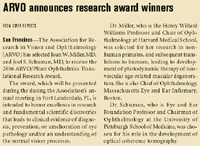Article
Glaucoma risk calculator, the need for adherence to medication take center stage in 2005
The landscape of glaucoma has been relatively quiet during 2005, but experts in the field agree there have been a few noteworthy developments.

For a wrap-up of some of the important advances that have occurred in both basic and clinical science, Ophthalmology Times spoke with Robert D. Fechtner, MD, Eve J. Higginbotham, MD, Harry A. Quigley, MD, and Robert N. Weinreb, MD.
Risk calculator debut

"This is the first time a risk calculator for use in managing an ophthalmologic disease has been developed and validated, and our validation confirmed it provides fairly reliable predictions of probability risk," said Dr. Weinreb, distinguished professor of ophthalmology, University of California, San Diego, and director of the university's Hamilton Glaucoma Center.

"With this validated tool, clinicians are now positioned to make individual risk assessments for patients with ocular hypertension just as cardiologists have been doing to predict the 10-year risk of a coronary event using a combination of data on cholesterol, blood pressure, and other factors," said Dr. Fechtner, professor of ophthalmology, and director, glaucoma division, Institute of Ophthalmology and Visual Science, New Jersey Medical School, University of Medicine and Dentistry of New Jersey, Newark.

"This risk assessment analysis has been converted into an easy-to-use slide rule that was introduced at the annual meeting of the American Academy of Ophthalmology, and we can expect risk modeling will play an increasing role in glaucoma therapy in the future," said Dr. Quigley, A. Edward Maumenee Professor of Ophthalmology, and director, Glaucoma Service, Wilmer Eye Institute, Johns Hopkins University School of Medicine, Baltimore.

Newsletter
Don’t miss out—get Ophthalmology Times updates on the latest clinical advancements and expert interviews, straight to your inbox.




